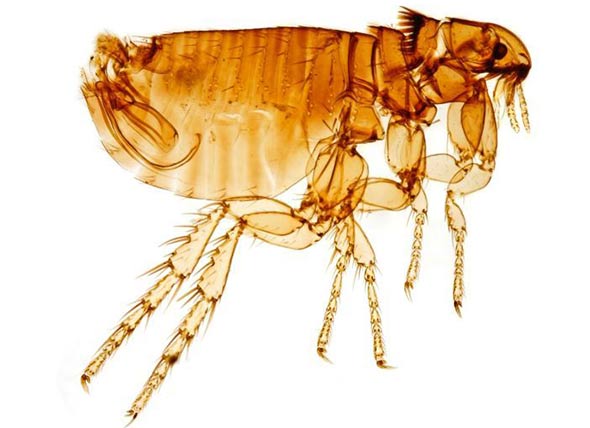
INTRODUCTION. Fleas are one of the more important groups of insect pests because they not only cause discomfort by biting, but they can transmit several diseases such as plague and murine typhus. Cat fleas are the most common domestic flea. In the United States, they are commonly found on both cats and dogs. Cat fleas are found throughout the United States and the rest of the world.
RECOGNITION. Adults about 1/8" (2.5 mm) long. Body laterally flattened (side to side); wingless. Color brownish black to black, but reddish black when full of blood. Female’s head twice as long as high. Compound eyes well developed. Both genal and pronotal combs present, each composed of 16 spines, and genal comb’s first 2 anterior spines of about equal length. Femur of hind leg with 7-10 bristles on inner side. Abdominal terga (dorsal plate of segments) 2-6 with a single row of bristles. In addition, antennae short, 3- segmented; ocelli lacking; legs long, coxae large, tarsi 5-segmented; usually jumping insects; mouthparts piercing-sucking with well-developed palps.
Females lay 4-8 eggs after each blood meal, laying some 400-500 during their lifetime. The eggs are smooth and not glued/stuck to the hairs or body but are deposited on or between hairs, or in the nest or bedding material. Hence, eggs deposited on the animal either fall or are shaken off, and are frequently found in cracks and crevices where pets sleep or frequent. Eggs are oval, whitish, and about 1/64" (0.5 mm) long. They usually hatch in about 2 days (range 1-12 days).
Flea larvae move about using the setal rings and abdominal struts/hooks. They have chewing mouthparts and feed on organic debris but almost all require dried fecal blood in order to complete development; they do not bite but feed on adult flea fecal blood. Larvae require high relative humidity (45-95%) and 1-2 weeks to several months to go through 3 instars. Last instar larvae then spin a cocoon and incorporate surrounding debris on its surface which provides camouflage. Under favorable conditions, the pupal stage may last 4-14 days or up to a year under harsh conditions. The pre-emerged adult remains in the cocoon for up to 20 weeks, where it is protected from adverse conditions, including pesticides. Adults are stimulated to emerge from the cocoon by mechanical depression of the cocoon, an increase in temperature, and possibly vibrations. Larvae and pupae are typically found where the animal sleeps or frequents.
Adults usually begin to seek a blood meal on the second day after emergence, but can live for several months on their stored body fat. Adults, unlike many other fleas, once on a host tend to spend all of their time on the host, feeding, mating, and laying eggs, unless dislodged. Although they have a preferred host, they will readily bite and can survive using other species as hosts. Depending on conditions, adults usually live only several days because normal cat grooming removes up to 50% of the fleas; otherwise, they can survive about a year.
Cat fleas may transmit plague. There is very strong circumstantial evidence that they may transmit murine typhus. Cat fleas serve as intermediate hosts of the dog tapeworm, Dipylidium canninum (Linnaeus), and the rodent tapeworm, Hymenolepis diminuta (Rudolphi). These tapeworms occasionally infest humans, especially very young children. The dog tapeworm commonly infests cats that spend time outdoors.
HABITS. It is not necessary to have pets in the building in order to have fleas present. Since fleas can jump about 6" (15 cm) vertically, they can easily hitch a ride on shoes, trousers, etc.
Many vacationers who may have been unaware of the few adult fleas present, are often greeted and severely attacked by fleas upon their return. This can occur even if the building has been vacant of animals and people for as long as 6 months or so. This situation can occur because of the potentially long pupal period, adults can live for months without food, and because fleas have not been removed via normal vacuuming. Also, fleas are normally removed from the interior environment by taking up residence on the pet(s).
Fleas are typically found where animals sleep or frequent, including along their usual avenue of travel, because this is where eggs and adult fecal blood accumulate. Most larvae will be found in similar places but especially in areas with high moisture which is necessary for their survival. Pupae will be found in the same situations as larvae. Such places include both indoor and outdoor situations. Cat fleas are also found on other urban hosts such as opossum, fox, mongoose, and occasionally rats.
Flea larvae die at relative humidities below 45% and above 95%, and hence, are rarely found outdoors in arid climates. Larvae fail to develop at temperatures below 55°F (13°C) and at or above 95°F (35°C).
CONTROL. Flea control is a 4-part process.
1. Wild animals such as rodents, opossums, etc., which are nesting in or frequently visiting the structure must be prevented from entering the structure and controlled with appropriate trapping devices or baits.
2. If the pet has fleas at the time of treatment, the pet owner must arrange for the pet to be treated. Treatment may be done by a veterinarian, grooming parlor personnel, or by the pet owner, but must be done on the day of treatment and either before or while the premises are being treated.
3. Indoor control. The homeowner or occupant must do the following just before the flea treatment: remove all items such as toys and pillows off the floor or carpet; remove all articles from under beds, on closet floors, and from under furniture; vacuum all upholstered furniture, floors, and carpeting, paying particular attention to the foot of the furniture on which the pet rests, under furniture, and wall-floor junctions. The vacuum bag must be immediately removed and put into a plastic garbage bag, the top sealed, and then placed in an outside garbage receptacle or burned. Thoroughly clean all areas frequented by cats, e.g. table tops, refrigerator tops, window sills, counters, etc. Cover aquariums and turn off the pumps prior to the treatment. Be sure to remove all pets, including birds.
4. Outside control. Minimally, spot treatment should be done. This consists of treating with an appropriately labeled pesticide and light-stable IGR, every place the animal rests, naps, or sleeps which are typically cool areas such as next to the building’s foundation, porch, etc., or under a bush or tree. In addition, band treatment is often helpful, especially if overall treatment is not going to be done. Band treatment is done with an appropriately labeled pesticide which is applied in a 6-10 foot band around the perimeter of the building. For dogs confined to a fenced-in yard, also treat the 3-4 feet adjacent to the fence on the side to which the dog has access. If the infestation is severe, overall yard treatment may be required and an appropriately labeled pesticide should be used. Wettable powder and microencapsulated formulations are particularly effective outdoors.
Our pest management treatment consists of applying an appropriately labeled pesticide and/or IGR as per label instructions with thoroughness being the key to success. We will use an IGR (insect growth regulator) on the initial treatment and reapply as per label instructions every 3-6 months throughout the flea season. For accounts that are susceptible to flea activity, it is recommended that the IGR alone be applied prior to the beginning of the next flea season as a preventative measure.
Please call us today for a free estimate for the elimination of these fleas.


